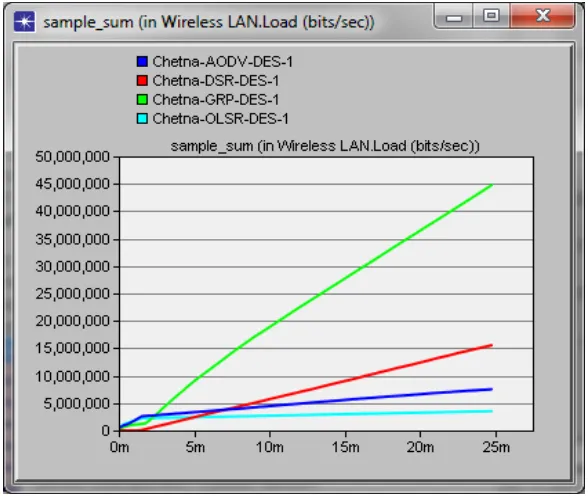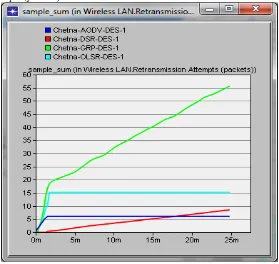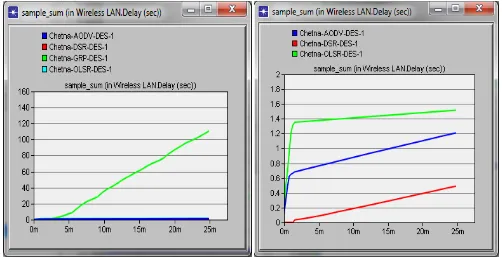© 2015, IJCSMC All Rights Reserved 226
Available Online atwww.ijcsmc.com
International Journal of Computer Science and Mobile Computing
A Monthly Journal of Computer Science and Information Technology
ISSN 2320–088X
IJCSMC, Vol. 4, Issue. 8, August 2015, pg.226 – 235
RESEARCH ARTICLE
Frequency Hopping Based Performance Evaluation of
AODV, DSR, GRP and OLSR for 1 Mbps Using OPNET
Chetna
1, Ramveer Singh
*2, Jonish
3¹M-Tech Department of CSE, GNIOT, Greater Noida, Uttar Pradesh, India
²Assistant Professor, Department of IT, GNIOT, Greater Noida, Uttar Pradesh, India
³Department of CSE, Sonepat, Haryana, India
1 chetnabaghel@gmail.com; 2 ramveersinghrana@gmail.com; 3 sbit.cse08420@gmail.com
Abstract— In this paper analysis and performance of AODV, DSR, GRP and OLSR is done for 1 mbps data rate. We used OPNET Simulation tool we created a network containing 30 mobile nodes with data rate 1 Mbps with transmission power 0.005 watts and buffer size 1024000 bits each node moves randomly in the network and simulation time was 1500 sec. Routing protocols are compared in terms of WLAN Load, WLAN Media Access Delay, WLAN Retransmission Attempts (packets), WLAN Throughput and WLAN Delay (sec). According to the analysis of resulted performance in 1 Mbps we can say that DSR>GRP>AODV>OLSR. The simulation result of the research has practical reference value for further study.
Keywords— AODV, DSR, GRP, OLSR, MANET, OPNET
I. INTRODUCTION
MANET is a dynamic distributed network. This dynamic nature makes the network topology to keep changes randomly. The mobility of nodes in MANETs results in frequent changes of network topology making routing in MANETs a challenging task. Routing protocol is the major issue in data communication’s performance of MANET. Protocols like AODV, DSR, GRP and OLSR in MANET helps node to send and receive packets and each node acts both as a router and as a host.Hence, routing protocol required is to be effective and accurate so as to handle mobility of nodes for giving best utilization to technology. Nodes are like laptop, computers and wireless phones have a limited transmission range for direct transmission.The success of communication depends on cooperation of other nodes. [5]
© 2015, IJCSMC All Rights Reserved 227
in order to reach the destination. AODV allows mobile nodes to respond to link breakages and changes in network topology in a timely manner. [1]
The Dynamic Source Routing (DSR) Protocol is a source routed on-demand routing protocol. A node maintains route caches containing the source routes that it is aware of. The node updates entries in the route cache when it learns about new routes. In its packet head, each given routing packet has a complete and ordered node list which the packet will pass inevitably. [2]
The Gathering based routing protocol (GRP) collects network information at a source node with a small amount of control overheads. According to the information collected, source node can find routes and continuously transmit data even if the current route is disconnected. Mobile Ad hoc network (MANET) is a dynamic network formed without the use of any existing infrastructure or centralized administration. Each device in a MANET is free to move independently in any direction due to its dynamic nature. The mobility of nodes in MANETs results in frequent changes of network topology making routing in MANETs a challenging task. The result of this approach is achieving fast transfer with less overhead of control massages. [3]
The Optimized Link State Routing Protocol (OLSR) is developed for mobile ad hoc networks (MANET’s). It operates as a table driven, proactive protocol, i.e., exchanges topology information with other nodes of the network regularly. Each node selects a set of its neighbor nodes as "multipoint relays" (MPR). In OLSR, only nodes, selected as such MPR’s, are responsible for forwarding control traffic, intended for diffusion into the entire network. MPRs provide an efficient mechanism for flooding control traffic by reducing the number of transmissions required. [4]
II. RELATED WORK
Narender[1] In this paper analysis of the performance of AODV routing protocol is done with the use of OPNET simulation tool, they created a 27 mobile nodes networks on data rate 1 and 11 Mbps and transmission power 0.005 watts with buffer size 256000 bits the time of simulation was 1200 sec. AODV routing protocol is compared in terms of AODV Route Discovery time, FTP Download Response Time(sec), HTTP Object Response Time (sec), WLAN Delay (sec) and AODV Total Cached Replies Sent in scenario for the simulation analysis and performances.
Parulpreet[2] This paper evaluates the performance of reactive (DSR) routing protocols in MANETs based on Average end-to-end delay, Throughput using OPNET 14.5. The performance DSR routing protocols is evaluated with respect to throughput and end-to-end delay under different traffic load using OPNET simulator.
Vineet[3] In this paper analysis of Comparative performance of Infra Red WLAN and Extended Rate PHY (802.11g) WLAN is done for 1 and 2 mbps data rate for GRP. We used OPNET Simulation tool we created a network containing 20 mobile nodes with data rate 1 Mbps and 2 Mbps with transmission power 0.005 watts and buffer size 1024000 bits each node moves randomly in the network and simulation time was 1500 sec. Infra Red WLAN and Extended Rate PHY (802.11g) WLAN is compared in terms of 1 Mbps for different QOS’s using GRP protocol.
© 2015, IJCSMC All Rights Reserved 228
network and simulation time was 2000 sec. OLSR routing protocol is compared in terms of OLSR Performance Topology changes, FTP Download Response Time(sec), HTTP Object Response Time (sec), WLAN Retransmission Attempts (packets) and OLSR MPR count .
III. SIMLATION SETUP
This research used software known as OPNET Modeler, Which is a tool provided by the OPNET Technologies in order to undertake the experimental evaluation; the version named OPNET Modeler 14.5 has been adopted for study [9]. OPNET is one of the most extensively used commercial simulators based on Microsoft Windows platform, which incorporates most of the MANET routing parameters compared to other commercial simulators. It simulates the network graphically and gives the graphical structure of actual networks and network components.
TABLE I
SIMULATION PARAMETERS
Simulation Parameter Value
Simulator OPNET Modular 14.5
Area 1500*1500
Network Size 30 Nodes
Data Rate 1 Mbps
Mobility Model Random waypoint
Simulation Time 1500 sec
Address Mode IPV4
Standard IEEE 802.11 Frequency Hopping
Routing Protocol AODV, DSR, GRP, OLSR
TABLE II AODV PARAMETERS
Attribute Value
ActiveRoute Timeout 4.0
Hello Interval(sec) Uniform(1,1.2)
Allowed Hello Loss 1
Net Diameter 35
Node Traversal Time(sec) 0.04
Route Error Rate Limit (pkts/sec) 10
Timeout Buffer 5
TTL Start 1
TTL Increment 2
TTL Threshold 7
Local Add TTL 2
Packet Queue Size (Packets) Infinity
Local Repair Enabled
© 2015, IJCSMC All Rights Reserved 229
TABLE III DSR PARAMETERS
Attribute Value
Request Table Size (nodes) 64
Maximum Request Table Identifiers 16
Maximum Request Retransmissions 16
Maximum Request Period (sec) 10
Initial Request Period (sec) 0.5
Non Propagating Request Timer 0.03
Maximum Buffer size (pkts) 100
Maintenance Holdoff Time (sec) 0.5
Maximum Maintenance Retransmissions 3
Maintenance Acknowledgement Timer 0.7
DSR Routs Exports Export
Packet Salavaging Enabled
Broadcast Jitter (sec) Uniform(0,0.01)
TABLE IV GRP PARAMETERS
Attribute Value
Hello Interval(Sec) Uniform(1,1.1)
Neighbor Expiry Time(Sec) Constant(25)
Distance Moved(Meters) 500
Position Request Timer(Sec) 10.0
Backtrack Option Enabled
Routes Export Enabled
Number Of Initial Floods 3
TABLE V OLSR PARAMETERS
Attribute Value
Willingness Willingness High
Hello Interval(sec) 3.0
TC Interval(sec) 10.0
Neighbor Hold Time(Sec) 8.0
Topology Hold Time(Sec) 20.0
Duplicate Message Hold Time(Sec) 20.0
Addressing Mode IPV4
TABLE VI
WIRELESS LAN PARAMETERS
Attribute Value
Physical Characteristics Frequency Hopping
Data Rate 1 Mbps
Short Retry Limit 9
© 2015, IJCSMC All Rights Reserved 230
Max Receive Lifetime (sec) 0.5
Buffer Size(bits) 1024000
Roaming Capability Enabled
Large Packet Processing Fragment
Fig. 1 shows the simulation environment of scenario containing 30 WLAN mobile nodes, one fixed WLAN Server, Application definition, Profile definition and Mobility config. We configure the nodes in the scenario to work with 1 Mbps data rate in Frequency Hopping.
Fig. 1 Network Model for 30 Nodes scenario
IV. PERFORMANCE MERICS
A. WLAN Load
© 2015, IJCSMC All Rights Reserved 231
B. WLAN Media Access Delay
It represents the global statistic for the total of queuing and contention delays of the data, management, delayed Block-ACK and Block-ACK Request frames transmitted by all WLAN MACs in the network.
C. WLAN Retransmission Attempts (packets)
It is the total number of retransmission attempts by all WLAN MACs in the network until either packet is successfully transmitted or it is discarded as a result of reaching short or long retry limit.
D. WLAN Throughput
It represents the total number of bits (in bits/sec) forwarded from wireless LAN layers to higher layers in all WLAN nodes of the network.
E. WLAN Delay (sec)
It is the time taken by a packet from the movement it is transmitted on the network by source node to reach the destination node.
V. SIMULATION RESULTS AND ANALYSIS
Figure (2 - 6) below shows WLAN Load, WLAN Media Access Delay, WLAN Retransmission Attempts (packets), WLAN Throughput and WLAN Delay (sec) in 30 mobile nodes scenario for IEEE 802.11 Frequency Hopping standard at data rate 1 Mbps with AODV, DSR, GRP and OLSR. The color scheme is showing the protocols behavior in different graphs which gives clear visual information on there performance. From these graphs we will conclude the behavior of all these routing protocols.
A. WLAN Load
© 2015, IJCSMC All Rights Reserved 232
According to simulation, as we can see in Fig. 2, Resulted Performance is GRP > DSR > AODV > OLSR
B. WLAN Media Access Delay
Fig. 3 Sample Sum for WLAN Media Access Delay in 1Mbps for AODV, DSR, GRP and OLSR
According to simulation, as we can see in Fig. 3, Resulted Performance is DSR > AODV > OLSR > GRP
C. WLAN Retransmission Attempts (packets)
© 2015, IJCSMC All Rights Reserved 233
According to simulation, as we can see in Fig. 4, Resulted Performance is GRP > OLSR > DSR > AODV
D. WLAN Throughput
Fig. 5 Sample Sum for WLAN Throughput in 1Mbps for AODV, DSR, GRP and OLSR
According to simulation, as we can see in Fig. 5, Resulted Performance is AODV > GRP > OLSR >DSR
E. WLAN Delay (sec)
Fig. 6 Sample Sum for WLAN Delay in 1Mbps for AODV, DSR, GRP and OLSR
© 2015, IJCSMC All Rights Reserved 234
VI. CONCLUSION
In this paper performance of AODV, DSR, GRP and OLSR is compared in terms of WLAN parameters like Load, Media Access Delay, Retransmission Attempts, Throughput and Delay. According to resulted performance we can say that DSR performed best for WLAN Media Access Delay and WLAN Delay while GRP performed best for WLAN Load and WLAN Retransmission Attempts and WLAN Throughput is found to be best in terms of AODV.
TABLE VII RESULTING VALUES
S.NO. PERFORMANCE METRICS AODV DSR GRP OLSR
1 WLANLOAD 3 2 1 4
2 WLANMEDIA ACCESS DELAY 2 1 4 3
3 WLANRETRANSMISSION ATTEMPTS 4 3 1 2
4 WLANTHROUGHPUT 1 4 2 3
5 WLANDELAY 2 1 4 3
AVERAGE PERFORMANCE IS –DSR>GRP>AODV>OLSR.
The simulation result of the research has practical reference value for further study.
REFERENCES
[1] Narender, Ravi Antil, Jonish “Different QOS Based Simulation Evaluation of AODV Protocol Using Direct Sequence for 1 Mbps and 11 Mbps Using OPNET”, IJCSMC, Vol. 4, Issue. 1, January 2015, pp. 36–44.
[2] Parulpreet, Ekta, Gurleen “Evaluation of various Traffic loads in MANET with DSR routing protocol through use of OPNET Simulator”, International Journal of Distributed and Parallel Systems (IJDPS) Vol.3, No.3, May 2012, pp. 75-83.
[3] Vineet Bansal, Ravi Antil, Jonish “Different QoS Based Comparative Simulation Evaluation of Infra Red and Extended Rate PHY (802.11g) Based on GRP Routing Protocol”, IJCSMC, Vol. 4, Issue. 1, January 2015, pp. 149–158..
[4] Narender, Ravi Antil, Jonish “Direct Sequence Based Performance Evaluation of OLSR for 1 Mbps and 11 Mbps Using OPNET”, IJCSMC, Vol. 4, Issue. 1, January 2015, pp. 26–35.
[5] Jonish, Kapil Chawla, Kuldeep Frequency Hopping Based Performance Evaluation of TORA and OLSR Routing Protocols Using OPNET IJCSMC, Vol. 3, Issue. 11, November 2014, pg.514 – 522
© 2015, IJCSMC All Rights Reserved 235
[7] Guo, L, and Peng, Y. (2010) “Performance evaluation for on-demand routing protocol based on OPNET modules in wireless mesh network” Computer and Electrical Engineering (Elsevier), vol. 37(2011), pp. 106-114.
[8] Kuldeep Vats, “Simulation and performance analysis of OLSR routing protocol using OPNET” IJARCSSE ,Vol. 2, Issue 2, Feb. 2012 .





